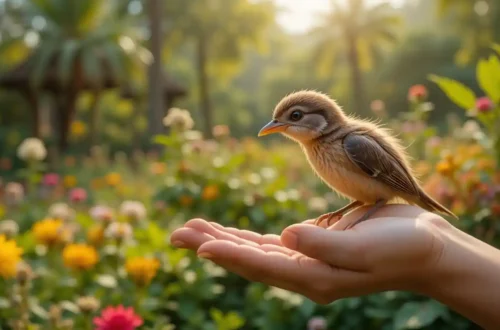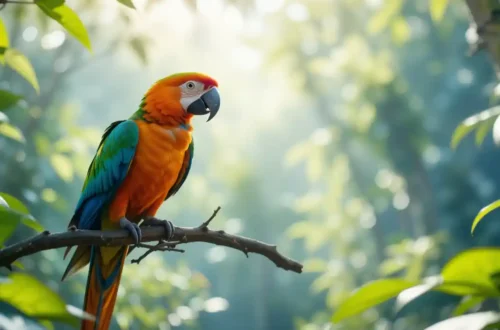Have you ever wondered what a bird thought question answers? It’s a question that leads us to delve into the intricate and captivating world of birds in India. Birds have long been admired for their beauty, flight, and diverse behaviors, but the idea of understanding what goes on in their minds opens up a whole new level of fascination. In this article, we will explore the rich birdlife of India, the behaviors that reveal their intelligence, and answer some of the most intriguing questions about what birds might be thinking.
Introduction to India’s Birds
India is a land rich in biodiversity, and its avian population is one of the most diverse in the world. From the regal peacock, which is the national bird of India, to the vibrant parrot, the skies of India are home to an impressive variety of bird species. India’s varied landscapes—ranging from dense tropical forests to the arid deserts and Himalayan heights—provide birds with a vast array of habitats. This diversity contributes to a wide range of bird behaviors and adaptations that make these creatures so intriguing to study.
What Do Birds Think?
Birds are far more intelligent than many people realize. While they may not think in the same way that humans do, their cognitive abilities and behaviors often suggest a depth of thought and emotion. Birds communicate with each other using a sophisticated system of songs, calls, and body language. These signals are used for a variety of purposes, from attracting mates to warning other birds of predators. Such complex behaviors make us wonder—what are birds truly thinking when they interact with each other or their environment?
What a Bird Thought Poem
To capture the essence of a bird’s thoughts, we can turn to poetry, where imagination blends with nature’s reality. Here’s a poem that evokes the daily musings of a bird:
“A bird perched high, with feathers so bright,
Thoughts of flight, and the morning light.
It sings a song, with a voice so clear,
A message to friends, and those who hear.”
This simple poem reflects the life of a bird—its constant awareness of its surroundings, its need to communicate, and its love of freedom through flight. Whether a bird is soaring across vast skies or perched on a tree, its thoughts are likely filled with the basic instincts of survival, communication, and connection.
Exploring Bird Intelligence in India
India offers a vast array of environments that enable birds to develop unique behaviors and intelligence. Here are a few key aspects of bird intelligence that we can explore:
Tool Use
Some bird species in India have been observed using tools, demonstrating their ability to solve problems. The Indian crow, for example, is known for its remarkable ability to use sticks to extract insects from tree bark or to break open tough food items like nuts. This is a clear sign of problem-solving and cognitive flexibility.
Migration Patterns
Many species of birds in India follow intricate migratory routes, often covering thousands of kilometers. These migratory patterns are passed down through generations, showcasing birds’ ability to remember and navigate through vast landscapes. The Indian migratory birds, like the Siberian crane, display remarkable navigation skills that have long fascinated scientists.
Social Behavior
Birds are social creatures, often found living in groups with complex structures. The social behaviors of Indian birds are a testament to their intelligence. For instance, the Indian myna is known to form tight-knit groups with established roles, such as sentries to warn of predators and foraging groups that share food. These cooperative behaviors are essential for survival and demonstrate social intelligence.
What a Bird Thought Question Answers: Common Queries
Let’s answer some of the most common questions about bird thoughts and behaviors:
Do Birds Think Like Humans?
While birds do not think like humans, they are capable of complex cognitive tasks. Their brains are different from human brains, but that doesn’t mean they lack the ability to make decisions, learn, or solve problems. Birds show emotional responses to situations, like stress or excitement, which suggests they have thoughts tied to their survival and well-being.
How Do Birds Communicate?
Birds use a variety of methods to communicate. Their songs and calls play a significant role in attracting mates, warning others of predators, and even conveying their emotional state. Birds like the koel and the crow have distinct calls that serve specific purposes, and the sounds can even vary depending on the region or time of day.

Can Birds Learn?
Yes, birds are capable of learning new things. Many birds, such as the common raven, have been observed learning new behaviors from other birds or humans. They can mimic sounds, recognize individual humans, and even use objects in their environment in creative ways.
Do Birds Have Emotions?
Although we can’t know for certain, bird behaviors strongly suggest that they experience emotions. Birds exhibit signs of affection, stress, fear, and joy. For example, parrots are known to form deep bonds with their human caregivers, showing attachment similar to that of pets like dogs and cats.
Bird Conservation in India
While India’s birds are fascinating, they face numerous threats to their survival. Habitat destruction, climate change, pollution, and hunting are just a few of the challenges that many bird species face in India. Conservation efforts are crucial for protecting the nation’s rich birdlife.
Conservation Efforts in India
India is home to numerous national parks and wildlife sanctuaries that provide protected areas for birds. These sanctuaries play a key role in preserving bird habitats and ensuring the survival of endangered species. Additionally, India has set up several bird sanctuaries like the Keoladeo National Park and Chilika Lake, which are crucial to the conservation of migratory birds.
Community Involvement
Local communities are often involved in bird conservation efforts, especially through eco-tourism and educational programs. These initiatives help raise awareness about the importance of protecting birds and their habitats, ensuring that future generations will continue to experience the wonder of India’s avian life.
Exploring Bird Behaviors in India
India’s birds display an astonishing range of behaviors, each adapted to its environment. Understanding these behaviors gives us a glimpse into how birds think and interact with their world.
Migratory Patterns in India
Many birds in India migrate across vast distances, traveling between breeding grounds in the north and wintering grounds in the south. Migration is an instinctual behavior, and it is guided by a combination of environmental cues like temperature, food availability, and daylight.
Social Behaviors in India
Birds like the Indian parrot and the langur birds form tight social bonds and live in cooperative groups. These birds often work together to forage, protect each other from predators, and care for the young. Their social structures are intricate and suggest that birds possess social intelligence necessary for their survival.
Conclusion
Exploring the world of India’s birds and considering what they might be thinking takes us on a fascinating journey through the minds of these remarkable creatures. From their intelligence and communication systems to their social behaviors and migrations, birds in India offer a wealth of knowledge. By appreciating their behaviors and thoughts, we can not only better understand their place in nature but also work toward protecting them for future generations. The next time you hear a bird’s call or see one soar through the sky, take a moment to ponder—what might this beautiful creature be thinking?






